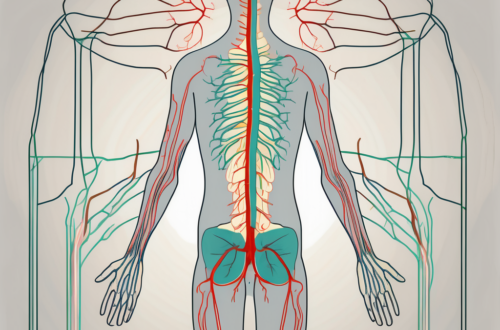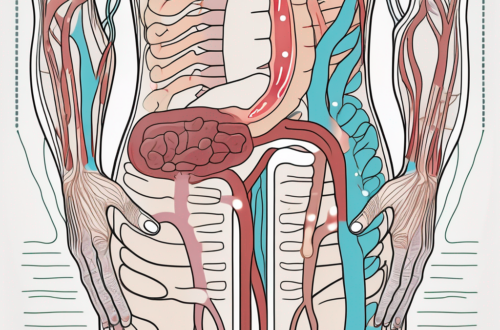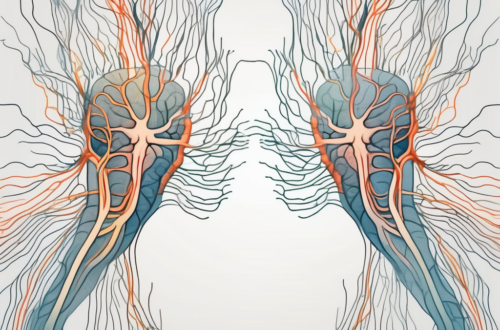The parasympathetic nervous system plays a crucial role in regulating heart rate. By understanding the intricate workings of this complex system, we can unlock the potential of parasympathetic nerve stimulation as a tool for reducing heart rate. In this article, we will delve into the science behind heart rate reduction and explore the effects of parasympathetic nerve stimulation on the body. We will also discuss the correlation between this stimulation and heart rate reduction, as well as the future of this promising therapy in cardiac medicine.
Understanding the Parasympathetic Nervous System
The parasympathetic nervous system is one of the three divisions of the autonomic nervous system. Its main function is to promote rest and relaxation by counterbalancing the sympathetic nervous system, which is responsible for our fight-or-flight response. The parasympathetic nervous system slows down heart rate, among other vital functions, allowing our bodies to conserve energy and recover.
When we think of the parasympathetic nervous system, we often associate it with a sense of calm and tranquility. It is like a gentle breeze on a warm summer day, soothing our bodies and minds. But what exactly happens within our bodies when the parasympathetic nervous system is activated?
Let’s dive deeper into the role of the parasympathetic nervous system in heart rate regulation.
The Role of the Parasympathetic Nervous System in Heart Rate Regulation
Heart rate regulation is a complex process involving the interplay between various biological factors. The parasympathetic nervous system, primarily through the release of acetylcholine, acts on the heart’s pacemaker cells, slowing down their firing rate and subsequently reducing heart rate. This process, known as vagal tone, is vital for maintaining a healthy balance in our cardiovascular system.
Imagine a symphony orchestra playing a beautiful melody. Each musician plays their part, creating a harmonious sound. In the same way, the parasympathetic nervous system orchestrates the rhythm of our heart, ensuring that it beats at a steady pace. It is like a conductor guiding the heart’s performance, ensuring that it stays in sync with the needs of our body.
But the parasympathetic nervous system’s influence extends beyond heart rate regulation. It also plays a crucial role in digestion, urination, and sexual arousal. When we enjoy a delicious meal, it is the parasympathetic nervous system that kicks in, allowing our bodies to properly digest and absorb nutrients. It is like a master chef in our bodies, ensuring that every bite we take is transformed into energy and nourishment.
The Anatomy of the Parasympathetic Nervous System
The parasympathetic nervous system consists of two main components: the cranial and sacral divisions. The cranial division originates from the brainstem, with the vagus nerve being its primary pathway. The sacral division emerges from the spinal cord’s sacral region. Both divisions innervate various organs, including the heart, to exert their regulatory effects.
Imagine the parasympathetic nervous system as a vast network of interconnected roads, with each division serving as a highway leading to different destinations within our bodies. The cranial division, with the vagus nerve as its main route, traverses through the brainstem, making stops at various organs along the way. It is like a traveler exploring different cities, leaving its mark wherever it goes.
The sacral division, on the other hand, emerges from the spinal cord’s sacral region, branching out like roots of a tree. It reaches out to the organs in the pelvic region, ensuring that they receive the parasympathetic influence they need. It is like a gardener tending to the plants, providing them with the care and nourishment they require to thrive.
Together, the cranial and sacral divisions of the parasympathetic nervous system form a comprehensive network that regulates various bodily functions. They work in harmony, like a symphony orchestra playing a beautiful melody, ensuring that our bodies function optimally.
The Science of Heart Rate Reduction
Heart rate reduction is not merely a physiological curiosity; it carries significant implications for our overall health and well-being. When the heart beats at a slower rate, it requires less oxygen and reduces the workload of the cardiovascular system. This can promote longevity, mitigate the risk of cardiac events, and improve the overall quality of life.
But what exactly happens in our bodies when we achieve heart rate reduction? Let’s delve deeper into the importance of heart rate reduction and the biological processes involved.
The Importance of Heart Rate Reduction
Maintaining an optimal heart rate is crucial for individuals with certain medical conditions, such as hypertension, arrhythmias, and heart failure. These conditions often lead to an increased heart rate, putting additional strain on the heart and compromising its efficiency.
By reducing the heart rate, we can alleviate symptoms and improve patients’ functional capacity. The heart becomes more efficient in pumping blood, allowing oxygen and nutrients to be delivered to the body’s tissues more effectively. This can lead to improved exercise tolerance, decreased shortness of breath, and enhanced overall well-being.
However, it is essential to note that heart rate reduction should always be guided and monitored by a healthcare professional. They will assess the individual’s specific medical condition, overall health, and any potential risks before recommending interventions.
The Biological Process of Heart Rate Reduction
Heart rate reduction can be achieved through various mechanisms, such as lifestyle modifications, pharmacological interventions, and therapeutic interventions like parasympathetic nerve stimulation.
Lifestyle modifications play a crucial role in heart rate reduction. Regular exercise, a healthy diet, and stress management techniques can help improve heart health and lower resting heart rate. Engaging in activities like yoga, meditation, and deep breathing exercises can activate the body’s relaxation response, leading to a decrease in heart rate over time.
Pharmacological interventions may also be prescribed by healthcare professionals to achieve heart rate reduction. Medications such as beta-blockers, calcium channel blockers, and certain anti-arrhythmic drugs can slow down the heart rate by blocking specific receptors or modulating electrical signals within the heart.
Furthermore, therapeutic interventions like parasympathetic nerve stimulation can be employed to reduce heart rate. This technique involves activating the parasympathetic nervous system, often referred to as the “rest and digest” system. By stimulating the vagus nerve, which is a major component of the parasympathetic nervous system, heart rate can be decreased. This can be achieved through techniques like deep breathing exercises, biofeedback, or even specific medical devices designed to stimulate the vagus nerve.
In conclusion, heart rate reduction is not only important for individuals with certain medical conditions but also for overall cardiovascular health. By understanding the significance of heart rate reduction and the various biological processes involved, we can make informed decisions about our lifestyle choices and seek appropriate medical guidance when needed.
Parasympathetic Nerve Stimulation Explained
Parasympathetic nerve stimulation is a technique that directly targets and activates the parasympathetic nervous system to reduce heart rate. The procedure involves the precise placement of electrodes near the vagus nerve, allowing for controlled stimulation and subsequent modulation of heart rate.
The parasympathetic nervous system, often referred to as the “rest and digest” system, plays a crucial role in maintaining homeostasis in the body. It counteracts the effects of the sympathetic nervous system, which is responsible for the “fight or flight” response. By activating the parasympathetic nervous system, parasympathetic nerve stimulation promotes relaxation and a decrease in heart rate.
The Procedure of Parasympathetic Nerve Stimulation
Parasympathetic nerve stimulation is performed by highly-trained medical professionals in a controlled clinical setting. The procedure typically involves the insertion of small electrodes near the vagus nerve, which transmits electrical impulses to activate the parasympathetic nervous system. This stimulation can be adjusted to achieve the desired heart rate reduction while ensuring patient safety.
Before the procedure, patients undergo a thorough evaluation to assess their suitability for parasympathetic nerve stimulation. This evaluation includes a detailed medical history review, physical examination, and various diagnostic tests to ensure that the procedure will be safe and effective for the individual patient.
During the procedure, the patient is positioned comfortably, and the skin around the targeted area is cleaned and sterilized. Local anesthesia is administered to minimize any discomfort during electrode placement. Using imaging techniques such as ultrasound or fluoroscopy, the medical professional precisely guides the electrodes near the vagus nerve.
Once the electrodes are in place, the medical professional carefully monitors the patient’s heart rate and adjusts the stimulation parameters accordingly. The stimulation duration and intensity may vary depending on the patient’s condition and response to the therapy. Throughout the procedure, the patient’s comfort and safety are of utmost importance.
The Effects of Parasympathetic Nerve Stimulation on the Body
Parasympathetic nerve stimulation effectively lowers heart rate by enhancing vagal tone. Beyond heart rate reduction, this therapy has shown potential in improving cardiac function, reducing symptoms in patients with heart failure, and even mitigating arrhythmias. However, further research is needed to fully understand and optimize its effects.
Studies have demonstrated that parasympathetic nerve stimulation can lead to improved heart rate variability, which is an indicator of cardiovascular health. By enhancing the parasympathetic activity, this therapy may help regulate blood pressure, reduce inflammation, and promote overall cardiovascular well-being.
In addition to its cardiovascular benefits, parasympathetic nerve stimulation has also shown promise in other areas. Research suggests that it may have a positive impact on mental health, reducing anxiety and stress levels. Furthermore, preliminary studies have explored its potential in treating conditions such as epilepsy, migraine, and even inflammatory bowel disease.
As with any medical procedure, parasympathetic nerve stimulation carries potential risks and side effects. These can include temporary discomfort or pain at the electrode insertion site, hoarseness or voice changes, and rare instances of infection or nerve damage. It is crucial for patients to discuss the potential benefits and risks with their healthcare provider before undergoing this therapy.
In conclusion, parasympathetic nerve stimulation is a technique that holds promise in the field of cardiovascular medicine and beyond. By targeting and activating the parasympathetic nervous system, this therapy offers a potential avenue for heart rate reduction and improvement in various health conditions. Ongoing research and advancements in technology will continue to refine and expand the applications of parasympathetic nerve stimulation, ultimately benefiting patients worldwide.
The Correlation between Parasympathetic Nerve Stimulation and Heart Rate Reduction
Parasympathetic nerve stimulation offers an exciting avenue for heart rate reduction and cardiovascular health. By directly manipulating the parasympathetic nervous system, we can target heart rate regulation more precisely. This correlation between stimulation and heart rate reduction has vast implications for those who may benefit from this form of therapy.
The Impact of Parasympathetic Nerve Stimulation on Heart Health
Parasympathetic nerve stimulation has the potential to greatly impact heart health by reducing heart rate and alleviating symptoms associated with certain cardiovascular conditions. This therapy works by activating the parasympathetic nervous system, which is responsible for the body’s “rest and digest” response. When the parasympathetic nervous system is activated, it releases neurotransmitters such as acetylcholine, which slows down the heart rate and promotes relaxation.
Studies have shown that parasympathetic nerve stimulation can be particularly beneficial for individuals with conditions such as hypertension, arrhythmias, and heart failure. By reducing the heart rate, this therapy helps to decrease the workload on the heart, allowing it to function more efficiently. Additionally, parasympathetic nerve stimulation has been found to improve heart rate variability, which is an important marker of cardiovascular health.
However, it is important to emphasize that this therapy should only be considered under the guidance of a healthcare professional. Each individual’s physiology and medical history must be carefully evaluated to determine whether parasympathetic nerve stimulation is an appropriate option. Factors such as the severity of the cardiovascular condition, the presence of any contraindications, and the overall health of the patient need to be taken into account.
The Potential of Parasympathetic Nerve Stimulation in Cardiac Therapy
As research continues to unfold, the potential of parasympathetic nerve stimulation in cardiac therapy becomes more apparent. This innovative approach holds promise as an adjunct therapy for cardiovascular conditions, but its specific applications and long-term effects require further investigation.
One area of interest is the use of parasympathetic nerve stimulation in combination with other treatment modalities. For example, it has been suggested that combining parasympathetic nerve stimulation with exercise therapy may yield greater benefits for individuals with cardiovascular conditions. By activating the parasympathetic nervous system and engaging in physical activity, patients may experience enhanced heart rate reduction and improved overall cardiovascular function.
Collaboration between clinicians, scientists, and engineers will be vital in advancing this field and optimizing patient outcomes. Ongoing research efforts aim to better understand the mechanisms underlying parasympathetic nerve stimulation and its effects on heart rate reduction. This includes investigating the optimal parameters for stimulation, such as frequency, intensity, and duration.
Furthermore, the development of innovative technologies and devices will play a crucial role in the widespread implementation of parasympathetic nerve stimulation as a therapeutic option. These advancements may include wearable devices that can deliver targeted stimulation, as well as improved monitoring systems to assess the efficacy of the therapy.
In conclusion, the correlation between parasympathetic nerve stimulation and heart rate reduction holds immense potential for improving cardiovascular health. While further research is needed to fully understand the long-term effects and optimal applications of this therapy, it represents a promising avenue for individuals with certain cardiovascular conditions. By harnessing the power of the parasympathetic nervous system, we can pave the way for more targeted and effective cardiac therapies.
Future Research and Developments
As with any emerging medical field, future research and developments are essential to refine our understanding and application of parasympathetic nerve stimulation. While the existing evidence is promising, there are limitations that warrant further exploration and controlled studies.
One area of future research in parasympathetic nerve stimulation is the investigation of its potential applications beyond cardiology. While the therapy has shown promise in regulating heart rate, its effects on other physiological processes and conditions remain largely unexplored. For example, researchers could investigate whether parasympathetic nerve stimulation can be used to modulate gastrointestinal motility or reduce symptoms in patients with gastrointestinal disorders.
Another avenue for future research is the optimization of stimulation parameters. Currently, the optimal frequency, duration, and intensity of parasympathetic nerve stimulation are not well-defined. By conducting systematic studies to determine the most effective parameters, researchers can enhance the therapy’s precision and maximize its therapeutic benefits.
The Limitations of Current Research
Current research on parasympathetic nerve stimulation is limited by its relatively recent emergence and the need for long-term follow-up data. Large-scale clinical trials with diverse patient populations will be instrumental in evaluating the therapy’s efficacy, safety, and potential side effects. Additionally, optimizing the stimulation parameters and exploring individualized treatment approaches would further enhance the therapy’s overall benefits.
One limitation of current research is the lack of standardized protocols for parasympathetic nerve stimulation. Different studies employ varying techniques and parameters, making it challenging to compare and synthesize the findings. Establishing a consensus on the methodology and protocols for conducting parasympathetic nerve stimulation studies would facilitate more robust and reliable research in the field.
Furthermore, the long-term effects of parasympathetic nerve stimulation remain unclear. While short-term studies have demonstrated its efficacy in reducing heart rate, the durability of these effects over extended periods is yet to be determined. Longitudinal studies with extended follow-up periods are necessary to assess the long-term benefits and potential risks associated with parasympathetic nerve stimulation.
The Future of Parasympathetic Nerve Stimulation in Cardiology
The future of parasympathetic nerve stimulation in cardiology holds great promise. As our understanding of heart rate regulation deepens, so too will our ability to develop innovative therapies. Parasympathetic nerve stimulation presents an exciting frontier for medical professionals, researchers, and engineers to collaborate, ultimately paving the way for personalized treatment strategies and improved patient outcomes.
One potential future development is the integration of parasympathetic nerve stimulation with other therapeutic modalities. Combining parasympathetic nerve stimulation with pharmacological interventions or other non-invasive therapies may have synergistic effects, leading to enhanced therapeutic outcomes. Exploring these combination approaches could revolutionize the field of cardiology and provide new avenues for managing cardiovascular conditions.
Additionally, advancements in technology hold promise for the future of parasympathetic nerve stimulation. Miniaturization of devices and the development of wireless stimulation systems could improve patient comfort and convenience. Furthermore, the use of artificial intelligence algorithms to optimize stimulation parameters based on real-time physiological data could enhance the therapy’s efficacy and individualize treatment approaches.
In conclusion, the impact of parasympathetic nerve stimulation on heart rate reduction has tremendous potential in the field of cardiology. By understanding the intricacies of the parasympathetic nervous system, we can harness its power and target heart rate regulation more precisely. As research advances, parasympathetic nerve stimulation may become an integral part of cardiac therapy, offering hope for those seeking to improve heart health and overall well-being. It is important, however, to consult with a qualified healthcare professional to determine the best course of action based on individual circumstances and medical history.





